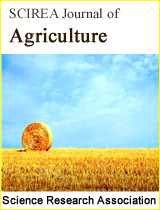Phenotype analysis of growth traits of KUB chickens fed with fermented cattle feces
DOI: 10.54647/agriculture21212 116 Downloads 14359 Views
Author(s)
Abstract
This research was conducted to analyze phenotypically the growth traits of KUB chickens consuming fermented cattle feces (FCF) feed. 120 head chicks were randomly placed in 4 treatments, i.e rations with 0% FCF (R0), 10% FCF (R1), 20% FCF(R2), and 30% FCF (R3). Each treatment consisted of 6 replications and each replication consisted of 4 chicks. The design used was a completely randomized design and the parameters studied were body weight, weight gain, feed consumption and feed conversion for the age period 0-8 weeks. The results showed that the R1 treatment was higher for all the parameters studied, but because the R0 treatment was not significantly different with the R2 and R3 treatments for both body weight at 8 weeks, and body weight gain for the period 0-8 weeks, so it can be said that KUB chicken can still grow well even if consuming feed containing 30% FCF. Feed consumption decreased in line with the increase in FCF level in the ration and R3 treatment had the best feed conversion ratio (2.95). Substitution of fermented cattle feces in commercial ration was able to reduce feed consumption, increse body weight and more efficient in feed consumption.
Keywords
Phenotype analisis, growth traits, KUB chickens, fermented cattle feces
Cite this paper
Franky M.S. Telupere,
Phenotype analysis of growth traits of KUB chickens fed with fermented cattle feces
, SCIREA Journal of Agriculture.
Volume 6, Issue 3, June 2021 | PP. 48-59.
10.54647/agriculture21212
References
| [ 1 ] | Bidura, I.G.N.G. and I.M. Suasta ( 2006). Appearance of native chickens aged 0- 8 weeks fed with goat pituitary flour through rations. Journal Articles. Animal Science Magazine. Udayana University. Denpasar. |
| [ 2 ] | Budiyanto, M.A.K. (2011). Typology of Cow Manure Utilization in Supporting Organic Agriculture in Sumbersari Village, Poncokusumo District, Malang Regency. Gamma Journal, 7 (1): 42-49. |
| [ 3 ] | East Java BPTP. (2018). KUB Chicken (Village Chicken Superior Balitbangtan). Ministry of Agriculture, Agency for Agricultural Research and Development, Center for Research and Development of Agricultural Technology in East Java. Indonesia |
| [ 4 ] | Eriko, Jatmiko and Nur H. (2016). Effect of partial substitution of commercial ration with rice bran on the performance of native chicken LLRD 2 27-33 |
| [ 5 ] | Guntoro S., M.R. Yasa, A.B.S. Dinata, I.W. Sudarma (2013). Utilization of Cow Feces for Feeding Male Bali Ducks. JPPTP. 16 (2). |
| [ 6 ] | Guntoro S., M.R. Yasa, A.A.N.B.S. Dinata, and I.W. Sudarma. (2016). The combination of using cow feces flour in rations and giving probiotics to laying native chickens. Bali Agricultural Technology Research Center. Journal of Biology 20 (2): 47-52. |
| [ 7 ] | Lestari E, Ismoyowati, Sukardi. 2013. Correlation between egg weight and hatching weight and differences in weight loss in wild duck (Cairina moschata) and duck (Anas plathyrhinchos) eggs. Purwokerto (ID): Animal Science Journal. 1 (1): 163-169. |
| [ 8 ] | Mayora W.I, T. Syahrio, K. Nova, and R. Sutrisna (2018). Performance of the starter on kub chicken rationing with different crude protein. Journal of Animal Husbandry Research and Innovation Vol 2 (1): 26-31, April 2018. |
| [ 9 ] | Moharrery A. and M. Mirzaei (2014). Growth characteristics of commercial broilers and native chickens as predicted by different growth functions. Journal of Animal and Feed Sciences, 23, 2014, 82-89. The Kielanowski Institute of Animal Physiology and Nutrition, PAS, Jablonna. |
| [ 10 ] | N’dri A. L., B. H. W. Koua, V. S. Ahouchi, and A. B. Adepo-Gourène (2018). Body weight and growths curve parameters evaluation of three chicken genotypes (Gallus gallus domesticus) reared in claustration J. Advan. Vet. Anim. Res. 5 188-195 |
| [ 11 ] | Putri N.I., Gushayriyanto, and Depison (2020). Growth patterns, body weight, and morphometric of KUB chicken, Sentul chicken, and Arab chicken. Buletin of Animal Science 44(3): 67-72, August 2020. |
| [ 12 ] | Rahayu, B.W.I., A. E. P. Widodo, and R. Sarunggalo (2010). Growth performance of kampung and bangkok fowl crossing. Journal of Animal Science, December 2010, Pp. 77 - 81 |
| [ 13 ] | Rajkumar U, S. Haunshi, C. Paswan, M.V.L.N. Raju, S.V. Rama Rao, and R.N. Chatterjee (2017). Characterization of indigenous Aseel chicken breed for morphological, growth, production, and meat composition traits from India. Poultry Science 96:2120-2126 |
| [ 14 ] | Sami A. And Fitriani (2019). Feed Efficiency and Addition of Kub Chicken Bodies That Given Phytobiotics With Various Concentrations. Journal of Galung Tropical, 8 (2) Agust 2019, Pp. 147 – 155 |
| [ 15 ] | Sartika, T., Desmayati, S. Iskandar, H. Resnawati, A.R. Setioko, Sumanto, and E. Romjali (2013). Chicken KUB-1. Jakarta: IAARD Press. |
| [ 16 ] | Sinurat A.P., C. Hidayat, T. Haryati, T. Wardhani, and T. Sartika (2017). The Effect of BS4 Enzyme Supplementation on the Performance of Local Chicken-KUB during Growing Period) The Effect of BS4 Enzyme Supplementation on the Performance of Local Chicken-KUB during Growing Period). DOI: http://dx.doi.org/10.14334/ Pros.Semnas. TPV-2017-Pp.400-406 |
| [ 17 ] | Suryana (2017). Development of KUB Chicken in South Kalimantan. WARTAZOA Vol. 27 No. 1 year 2017 Pp. 045-052. |
| [ 18 ] | Telupere, F.M.S. (2020). The use of fermented cattle feces in the ration on production and reproduction performance Sabu and Semau native chickens. Journal of tropical animal production vol 21, no. 1 pp. 13-22, June 2020. |
| [ 19 ] | Ujianto, A. (2016). Raise the Most Superior Native Chickens Broilers and Layers KUB. The publisher of PT. Agro Media Library. Jakarta. |

